Case study
Generating publishable neuroscience research in 12 weeks with ioGlutamatergic Neurons
This case study showcases the research of Professor Deepak Srivastava's lab at King’s College London, and their use of cutting-edge human iPSC-derived cells to optimise their experimental timelines in their recent publication identifying schizophrenia risk factors.

This case study showcases the research of Professor Deepak Srivastava's lab at King’s College London, and their use of cutting-edge human iPSC-derived cells to optimise their experimental timelines in their recent publication identifying schizophrenia risk factors.
It took Professor Deepak Srivastava’s lab at King’s College London just 12 weeks to generate publishable data on schizophrenia risk factors. This dramatically short research timeline was driven by the lab’s push to maximise the value of their students’ time at the bench and was achieved by adopting precision reprogrammed human iPSC-derived glutamatergic neurons in their experiments.
In this case study, you will learn:
- About Professor Srivastava’s research on the molecular mechanisms that impact cognitive function, and his focus on Schizophrenia.
- How his lab use hiPSC-derived excitatory neurons to model key triggers that may impact an individual’s propensity to develop schizophrenia during their lifetime.
- How the use of opti-ox powered human iPSC-derived cells has enabled his lab to optimise their time at the bench.
V2
2024
bit.bio
